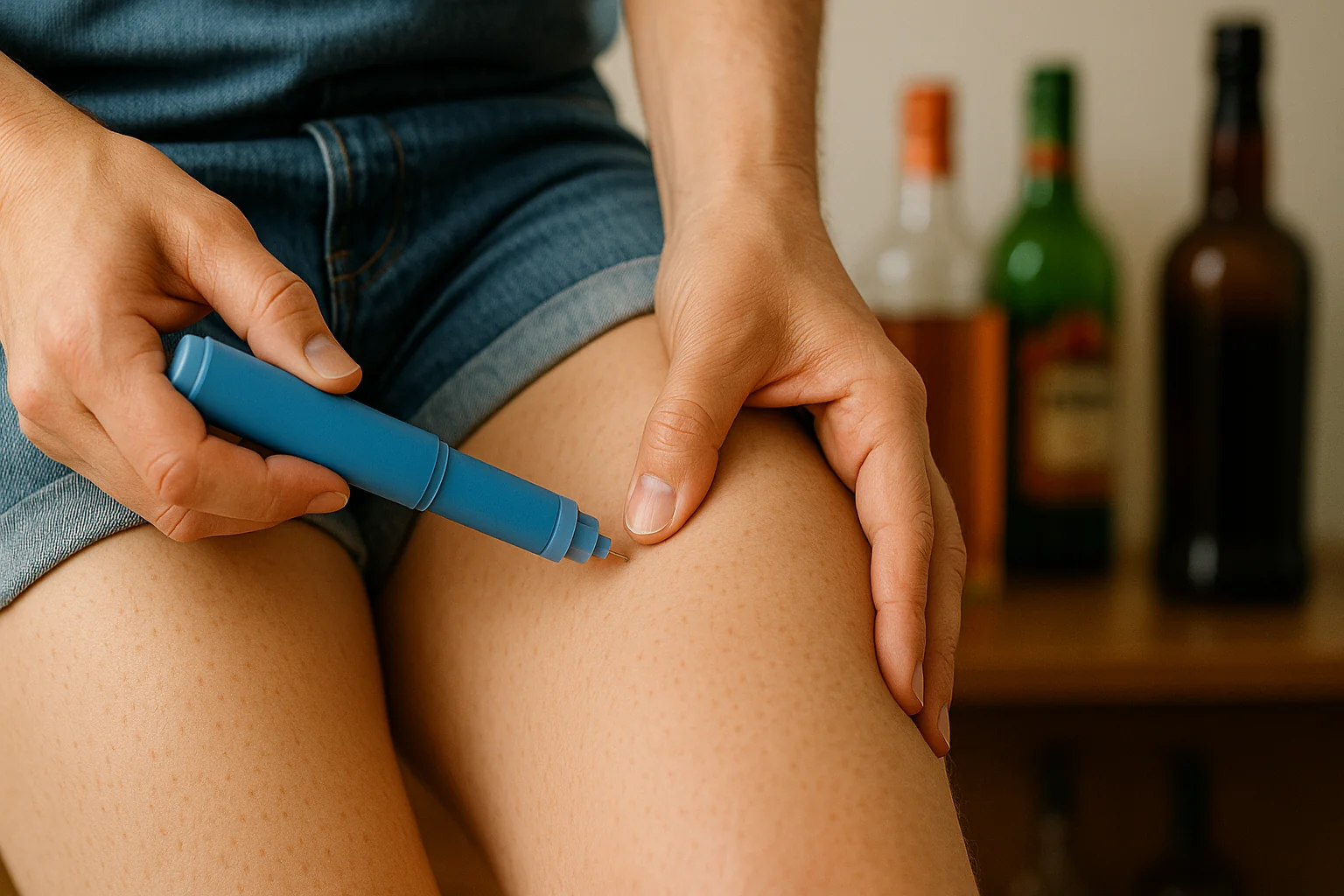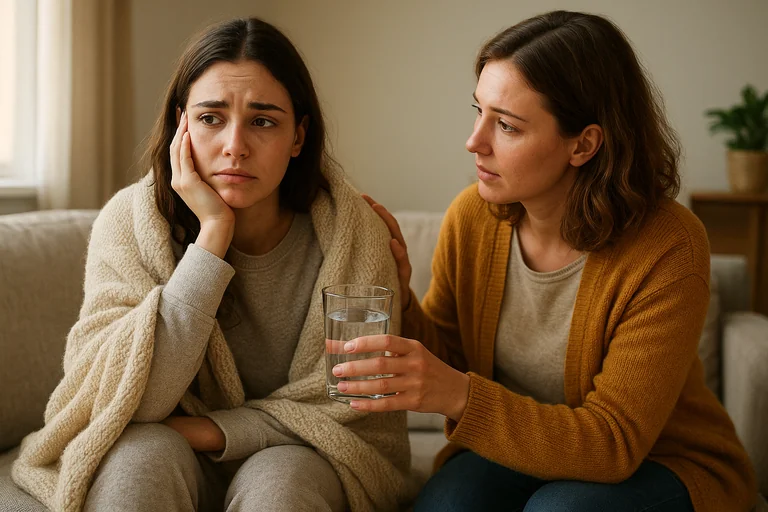A 2 minute assessment to get a personalized mental health or alcohol recovery plan.
GLP-1 medications like Ozempic show promising early evidence for reducing drinking, but they're not yet FDA-approved for alcohol use disorder—and naltrexone remains the guideline-endorsed first choice with the strongest evidence.
What You'll Discover:
- What the latest research shows about GLP-1s and drinking
- How medications like semaglutide work on alcohol cravings
- Why naltrexone is still the first-line choice for most people
- When adding a GLP-1 might make sense
- Important safety considerations and side effects
- A practical step-by-step approach if you're considering GLP-1s
If you've seen headlines about Ozempic, Wegovy, or other GLP-1 medications helping people drink less, you're not imagining it. This is one of the most exciting and fast-moving areas in addiction medicine right now. But the takeaways can get muddled: Which GLP-1s actually help? How strong is the evidence? Do they replace naltrexone? What are the risks?
The first thing to know is this: there's now real human evidence that certain GLP-1 medications can reduce drinking, but these drugs aren't FDA-approved for alcohol use disorder yet. The first-line treatment according to the American Psychiatric Association remains naltrexone or acamprosate, combined with behavioral support.
This guide will walk you through what we know, what we don't, and how to make a safe, practical plan that doesn't leave you waiting on hype while effective options exist today.
The Quick Summary
A 2025 systematic review of GLP-1 medications across substance use found promising signals, but emphasized we still need more and longer trials. GLP-1s aren't yet FDA-approved for alcohol use disorder, and the evidence base—while growing—remains early-stage.
Meanwhile, naltrexone has decades of research, FDA approval for alcohol use disorder, and widespread availability through telehealth at a fraction of the cost. If you're trying to cut back on drinking, you can start with evidence-based medication and behavioral support now, without waiting for future GLP-1 approvals.
Why a Diabetes Drug Would Affect Drinking
GLP-1 receptor agonists—including semaglutide (Ozempic, Wegovy), liraglutide (Saxenda, Victoza), and exenatide (Byetta)—mimic a gut hormone involved in appetite and reward signaling. Originally developed for diabetes and weight management, these medications work throughout the body, including in the brain.
In the brain, GLP-1 receptors sit in the reward circuits that influence "wanting"—for food and for alcohol. That overlapping neurobiology helps explain why some people on GLP-1 medications spontaneously report less desire to drink.
Think of GLP-1s as turning down the volume on the reward pathway. For some people, that means fewer "I need a drink" spikes. For others, it just makes stopping at one or two drinks easier.
What the Research Actually Shows
Semaglutide: The First Positive Clinical Trial
A 2025 randomized, double-blind, placebo-controlled trial tested weekly semaglutide in adults with alcohol use disorder. The results showed fewer heavy-drinking days and lower overall alcohol consumption compared to placebo. This is the most persuasive human evidence to date that GLP-1 medications can reduce drinking, not just appetite for food.
It's important to note that semaglutide was not FDA-approved for alcohol use disorder in this study—it was used off-label under research protocols. But the findings are encouraging.
Why might semaglutide work better than earlier GLP-1 drugs? It has the longest half-life and most robust metabolic effects in its class, and it may penetrate brain reward circuits more meaningfully, which could explain the stronger results.
Exenatide: Mixed Results Overall
A rigorous 2022 clinical trial of exenatide (given once weekly) in people with alcohol use disorder didn't show a significant benefit on the primary outcome in the full sample. However, participants with obesity did show reductions in heavy drinking. This suggests that who you treat matters—your BMI and metabolic profile may influence whether GLP-1s help with drinking.
The Bigger Picture
The evidence is accumulating, but it's still early and inconsistent across different medications, doses, and populations. The term researchers use is "promising but not yet definitive."
Where GLP-1s Fit with Standard Alcohol Treatment
According to major medical guidelines, first-line treatment for moderate-to-severe alcohol use disorder is naltrexone or acamprosate, supported by behavioral therapy. GLP-1 medications are not standard of care for alcohol use disorder yet—when used for this purpose, they're off-label.
Think of GLP-1s as a potential add-on, especially if you have overweight or obesity, metabolic syndrome, or if cravings tend to cluster around mealtimes or evenings. They may also be worth considering if you've already tried naltrexone and want additional support.
All that said, if you're on a GLP-1 for weight loss or diabetes and you're drinking less without trying—that's great. But if reducing drinking is your main goal right now, naltrexone remains the most accessible, guideline-endorsed place to start.
Benefits You Might Notice on a GLP-1
People taking GLP-1 medications for weight or diabetes sometimes report unexpected changes in their drinking patterns:
Lower urge intensity - Many describe the desire to drink as quieter or easier to ignore. The "pull" to open that first beer just isn't as strong.
Fewer heavy-drinking days - The highest-quality semaglutide study found reductions in heavy-drinking days compared to placebo. Heavy-drinking days are defined by NIAAA as four or more drinks for women, five or more for men in a single occasion.
Better first-drink control - For some people, stopping at one or two drinks becomes less of a struggle. The automatic reach for the third drink doesn't happen.
Metabolic benefits - Weight loss, improved blood sugar control, and lower cardiovascular risk are independent benefits that come with GLP-1 medications, regardless of any effect on drinking.
Drawbacks and Risks to Consider
Gastrointestinal side effects are the most common issue, especially during dose increases. Nausea, vomiting, and constipation affect many people starting GLP-1 medications.
Rare but serious risks include pancreatitis and thyroid concerns. GLP-1 medications are contraindicated if you have a personal or family history of medullary thyroid carcinoma or Multiple Endocrine Neoplasia syndrome type 2 (MEN2).
Cost and access can be significant barriers. Insurance typically covers GLP-1 medications only for diabetes or obesity indications. Getting one covered solely for alcohol reduction is currently unlikely, and out-of-pocket costs can exceed $1,000 per month.
Alcohol and GI effects can compound each other. If you do drink while on a GLP-1, alcohol can worsen nausea or impair hydration, so planning meals and fluids becomes more important.
Not a standalone solution - Even in research trials, behavioral support still matters. Combining medication with skills and support consistently outperforms either approach alone.
How GLP-1s and Naltrexone Differ
Understanding how these medications differ helps you make informed decisions about which to start with.
Regulatory status: GLP-1s are off-label for alcohol use disorder, while naltrexone is FDA-approved as first-line treatment.
How they work: GLP-1s modulate appetite and reward signaling throughout the brain and body. Naltrexone specifically blocks opioid receptors, which blunts alcohol's rewarding "buzz"—it makes drinking feel less fun and less compelling.
Clinical evidence: Naltrexone has robust evidence across multiple large trials and is endorsed by clinical guidelines. GLP-1 evidence for alcohol use disorder is emerging, with semaglutide showing the most promise but other medications showing mixed results.
Who benefits most: GLP-1s may work best for people with overweight or obesity and metabolic issues, especially those whose cravings link to food and eating patterns. Naltrexone works across a broad alcohol use disorder population, especially for reducing heavy-drinking days.
Access and cost: Naltrexone is inexpensive, widely covered by insurance, and easy to start via telehealth. GLP-1s are often expensive without obesity or diabetes coverage.
Typical role: GLP-1s are currently best thought of as an adjunct—an add-on while we await more trials and approvals. Naltrexone is the foundation, with or without therapy.
So, which should you start with? If your main goal is to cut back on drinking safely right now, start where the evidence and access are strongest—naltrexone. Then consider a GLP-1 add-on with your clinician if it fits your health profile and insurance coverage.
A Practical Step-by-Step Approach
If you're curious about whether GLP-1 medications might help you, here's a sensible path forward.
Step 1: Start with Evidence-Based Treatment
Begin with a first-line medication for alcohol use disorder—most often naltrexone—and pair it with tracking and brief coaching so you can actually see changes in your heavy-drinking days and total drinks per week. This gives you a baseline to work from.
For more background, read our guide on what medicines can help you quit drinking.
Step 2: Optimize Your Routine
If you're using daily naltrexone, take it at a consistent time each day—taking it with breakfast helps with any stomach discomfort. If you're using the Sinclair Method approach, take naltrexone one to two hours before any planned drinking windows.
Track your cravings on a 0-10 scale, count your drinks, and note the context for at least two weeks. This data becomes incredibly valuable for spotting patterns.
Step 3: Discuss GLP-1 Candidacy with Your Clinician
You're a better candidate for adding a GLP-1 if you have a BMI of 27-30 or higher, prediabetes or diabetes, or other cardiovascular risk factors. Your clinician will review contraindications like history of pancreatitis or MEN2, check your current medications, and verify insurance criteria.
Step 4: If You Add a GLP-1, Start Slowly
Dose escalations drive most side effects. When starting a GLP-1, prioritize protein, fiber, and hydration. Limit alcohol during the first few weeks of dose increases, because combining GI side effects with alcohol can make for rough nights.
Step 5: Keep What's Working
Don't drop naltrexone or behavioral strategies just because you've added a GLP-1. The combination of naltrexone plus GLP-1 plus skills makes rational sense while the evidence continues to develop.
Step 6: Measure What Matters
Check in at weeks 4, 8, and 12. Look at heavy-drinking days, total drinks per week, craving intensity, and functional improvements like sleep quality, mood stability, and how your mornings feel. If there's no meaningful signal by 8-12 weeks beyond expected weight effects, revisit the plan with your clinician.
Common Questions About GLP-1s and Drinking
Is it safe to drink alcohol while on a GLP-1?
Alcohol and GLP-1 medications don't have a dangerous drug interaction, but together they can worsen nausea and dehydration. If you drink while on a GLP-1, eat first, go slow, and stay well-hydrated.
Could a GLP-1 replace naltrexone for alcohol use disorder?
Not at this time. Clinical guidelines still recommend naltrexone or acamprosate as first-line treatment, with the best evidence for reducing heavy-drinking days. GLP-1s are promising—and for some people, very helpful—but they're not a replacement yet.
Does the specific GLP-1 medication and dose matter?
Very likely, yes. Trials vary by which molecule they use, what dose they give, and what population they study. The semaglutide trial signal is strong, while earlier medications like exenatide have shown mixed results overall with benefits mainly in people with higher BMI.
What if my drinking mostly happens on weekends?
That actually fits the "heavy-drinking day" outcome that many trials track. Use a weekly view when tracking your progress—Friday and Saturday often tell the story. Focus on reducing those high-risk days rather than achieving perfect daily abstinence.
How GLP-1s and Naltrexone Feel Different
People describe the subjective experience of these medications differently:
Naltrexone often feels like: "The buzz isn't as compelling. The magic is gone. It's easier to stop after one or two."
GLP-1 often feels like: "The urge is quieter. I'm less interested in starting. I don't think about drinking as much."
Some people appreciate the two-lever approach—blunting both the pull to start drinking and the reward from continuing.
Safety Checklist Before Starting
1. Before adding any new medication, review these safety considerations with your clinician:
2. Talk to a doctor if you have a history of pancreatitis, gallbladder disease, MEN2, or thyroid nodules. These are important contraindications for GLP-1 medications.
3. Share all medications and supplements you're taking, including naltrexone, antidepressants, and any herbal products.
4. f you might need opioid pain medications for surgery or injury, remember that naltrexone blocks opioids—you'll need a plan worked out in advance.
5. Expect GI symptoms as GLP-1 doses increase. Titrate slowly, stay hydrated, and prioritize protein and fiber in your diet.
6. Track heavy-drinking days and total drinks per week. These are the outcomes that matter most for health risk, not perfect abstinence streaks.
What This Means for Your Next 30 Days
If your goal is to start drinking less now, you don't need to wait for future GLP-1 approvals or more research.
Begin with a first-line medication for alcohol use disorder and proven behavior strategies. These work today, are covered by insurance, and have decades of research backing them.
Layer a GLP-1 if and when it's clinically appropriate and covered by your insurance to support reward control and metabolic health.
Use objective tracking so you and your clinician can see what's actually changing, not just what feels different.
For more context on alcohol use disorder as a spectrum condition rather than a simple label, read our guide on understanding alcohol use disorder.
How Choose Your Horizon Fits
We specialize in naltrexone-assisted alcohol reduction delivered through telehealth—fast access, transparent pricing, and coaching support to help you implement changes in daily life.
If you're already taking a GLP-1 for weight loss or diabetes, our clinicians can coordinate care around it. If you're curious about GLP-1s, we'll give you a clear picture of benefits and trade-offs and help you build a plan that prioritizes safety and results—starting with what works best today.
Looking Ahead
The research on GLP-1 medications for alcohol reduction is genuinely exciting. The semaglutide trial results are encouraging, and the underlying neurobiology makes sense. But we're still in the early chapters of this story.
More trials are underway, and over the next few years we'll learn which GLP-1 medications work best, at what doses, and for which populations. We'll also see whether FDA approval for alcohol use disorder happens, and whether insurance coverage follows.
In the meantime, you don't have to wait. Effective, proven treatment exists today.
Ready to take the guesswork out of cutting back? Start with a brief, confidential assessment to see whether naltrexone-assisted telehealth is a good fit and what your personalized next steps look like.
References
- Systematic review of GLP-1 receptor agonists for alcohol-related behaviors (2025)
- American Psychiatric Association Practice Guideline for Pharmacological Treatment of Alcohol Use Disorder
- NIAAA: Understanding alcohol drinking patterns and heavy-drinking days




